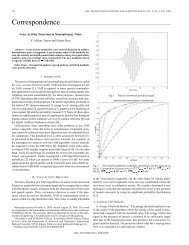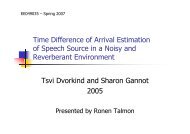Thesis (PDF) - Signal & Image Processing Lab
Thesis (PDF) - Signal & Image Processing Lab
Thesis (PDF) - Signal & Image Processing Lab
You also want an ePaper? Increase the reach of your titles
YUMPU automatically turns print PDFs into web optimized ePapers that Google loves.
38 CHAPTER 3. IMPLEMENTATION OF BTVT<br />
path for those flat zones. A TD-tree (VT DT , ET DT ) is a sub-graph of the TD-graph.<br />
The vertex set is the same, but ET DT ⊆ ET D. A TD-tree includes no skeleton points,<br />
because all multiple minimal pathes were removed, leaving a single path for every flat<br />
zone. In the TD-Tree, the root node is the boundary of the image.<br />
An example of this tree representation is shown in Fig. 3.1. In this example, the<br />
source image consists of 4 flat zones: a background component V1, a small simple<br />
component V2 located on the background, and a complex component V3 that includes<br />
a component V4. The resulting tree, shown in the same figure, contains information<br />
about topographic distance and gray level of each flat zone.<br />
Figure 3.1: An example of a given image and its TD-tree. Each flat zone of the image<br />
corresponds to a node of the TD-tree (indicated by the letter V, followed by the node<br />
number), its gray-level (shown in the variable GL), and its boundary topographic<br />
distance (shown in the variable TD).<br />
3.2 Topographic Distance Tree implementation<br />
Our implementation of the TD-Tree is based on the algorithm of Moore, reviewed in<br />
[22]. This is an efficient algorithm for finding the topographic distance function of<br />
a given flat zone of an image. The original algorithm of Moore calculates the topo-<br />
graphic distance, but does not keep the path variation of each flat zone. Therefore,<br />
we have adapted the algorithm of Moore, so that not only does it calculate the topo-<br />
graphic distance, but also builds the TD-Tree. Another proposed modification of the<br />
Moore algorithm is the use of the modified cost function described in (2.18). In every<br />
iteration of the Moore algorithm, the value of the topographic distance function for<br />
a new flat zone is computed. This new flat zone is the nearest neighbor (according
















